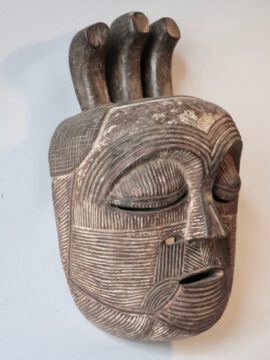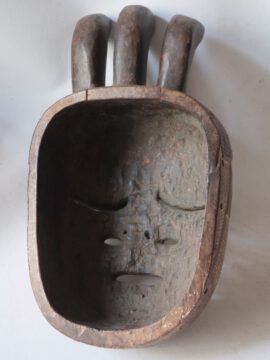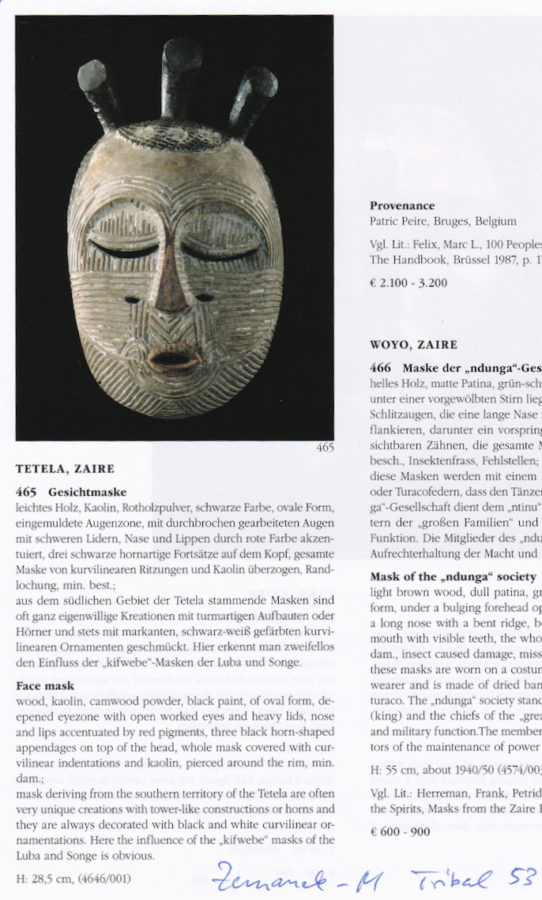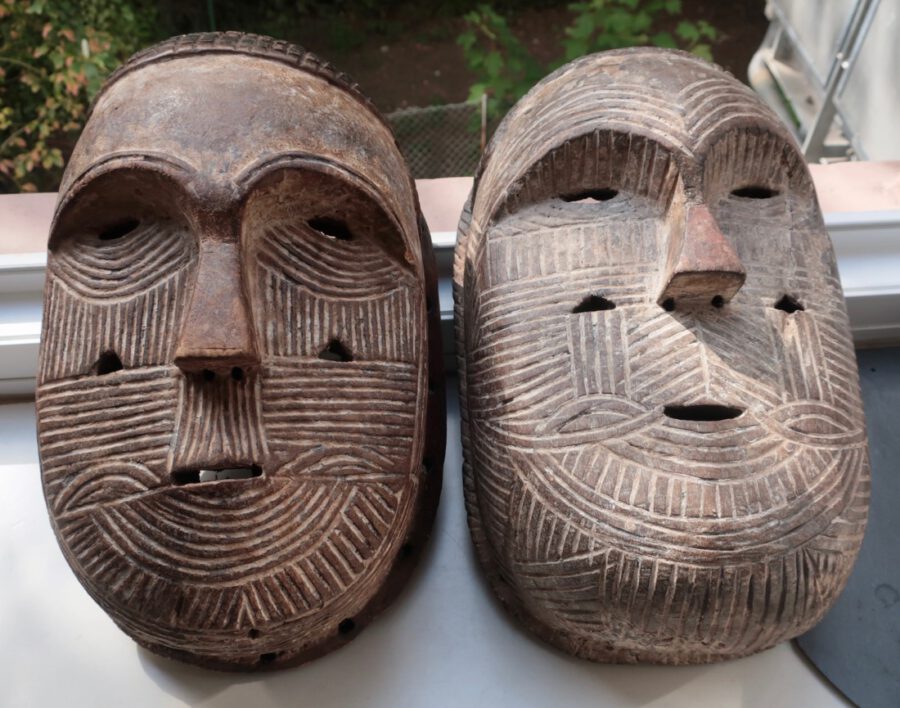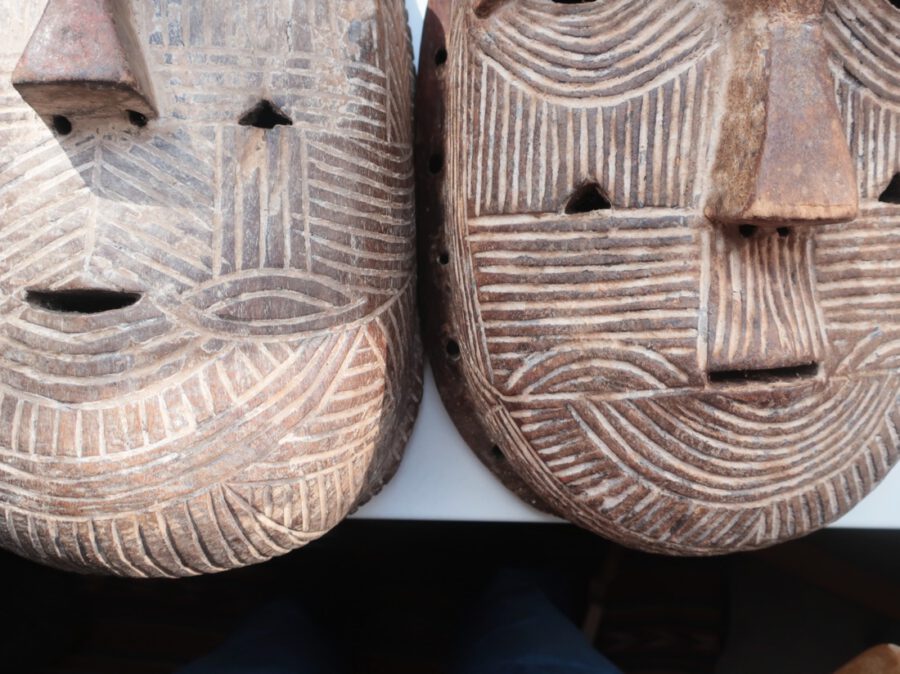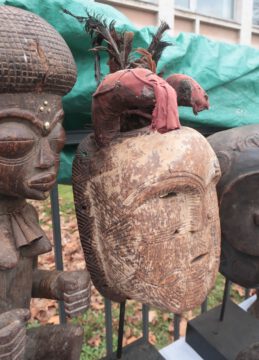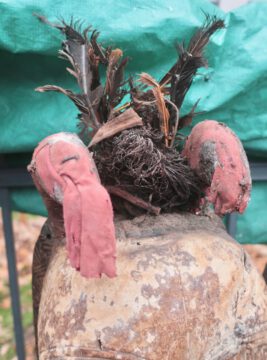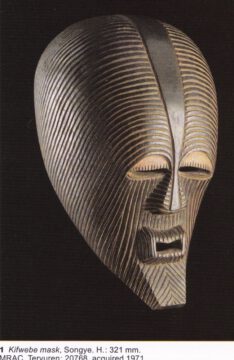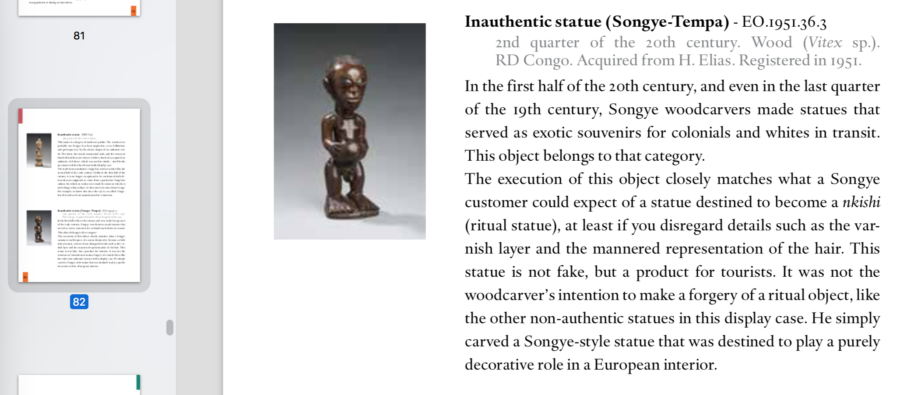Upload 3/11/23 Addition 7/1/24
August 1st, I put online three article based on an essay of Luc de Heusch – after the Migrations and Colonial history of the Tetela (LINK, deutsch) and Magic Figures of the Jonga (LINK, deutsch) and the „pseudo-Tetela Masks“ (de Heusch) from the northern border of the Songye settlement (LINK, deutsch). I will not translate them, because the underlying article was published in English: „Beauty is elsewhere: Returning a verdict on Tetela masks, Historical and ethnological notes on the Nkutshu„, in „Objects – Signs of Africa, Selected and edited by Luc de Heusch on the occasion of the „Hidden Treasures“, exhibition at the Musée de l’Afrique centrale Tervuren, Belgium pp.175 -204.
The text of de Heusch is as complex as its title, and I have taken my translation as opportunity to regroup it according to the needs of presumably interested art collectors.
The English version here focuses on the comparison of four masks in my collection and additional pieces
The Tempa are a small group of the Songye and live together with Tetela and others, for example in the town of Tempa on the Sankuru River. Also Neyt and Hersak identify them on their maps as Songye. Tempa masks are little published, they differ from the ‚classic‘ Songye style and have been popularly attributed to „the Tetela“, as well as by my Congolese dealer W., himself a „Tetela“.
In any case, I don’t know anything about the use of the masks, beyond what exhibition catalogs convey in general terms about the „Kifwebe“ association and its role. The study of de Heusch is an exception with his arguments against the mainstream from Emile Torday (1911) to Francois Neyt (1992), who offer him the opportunity to combine his field experiences in the region with the history of research. The results are detailed and vivid explanations and stories.
Description of “TEMPA” MASK WITH HORNS on March 19, 2023. ONE
Proportions: About 35 cm high, of which the strong “claws” make up 10 cm , depth 16 cm at the forehead and 13 cm at the chin, width 22.5 cm; horns 10cm, forehead to the right and left of the bridge of the nose 7cm, eyebrow arch to the tip of the nose 10cm, mouth and chin 10cm.
Except for the angular triangular nose, everything is convex. The three horns are not actually horns, but rather strong fingers. The carefully drawn and white-filled lines are best protected in fields clearly divided by red (pigment residues) under the chin and on the sides. ; parallel but freely drawn grooves.
W: “Carved with respect”
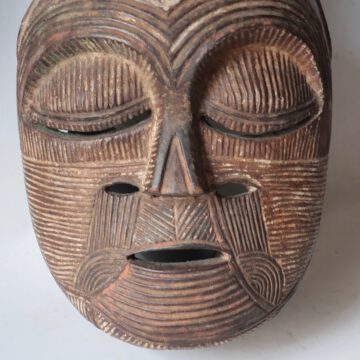 The decor prevails everywhere, except for the forehead, the three horns and the three depressions, as well as the smooth, straight bridge of the nose decorated with a triangle. Parallel lines and the hairstyle in small squares. Receding hairline similar to that of the Kuba-Bushong or Dengese but on flattened skull. Regular thickness of the dense, medium-heavy wood, appropriate for the big amount of work. Edges of the grooves show shiny wear, carefully on the mouth and nose; the short vertical grooves at the bottom of the eyelids could suggest eyelashes.
The decor prevails everywhere, except for the forehead, the three horns and the three depressions, as well as the smooth, straight bridge of the nose decorated with a triangle. Parallel lines and the hairstyle in small squares. Receding hairline similar to that of the Kuba-Bushong or Dengese but on flattened skull. Regular thickness of the dense, medium-heavy wood, appropriate for the big amount of work. Edges of the grooves show shiny wear, carefully on the mouth and nose; the short vertical grooves at the bottom of the eyelids could suggest eyelashes.
Comfortable interior, no sharp edges, good visibility under the heavy eyelids and also downwards through small openings at the end of the nose. A bundle of parallel lines radiates from them, which elsewhere is said to mean tears. Shine inside the nose area. Careful repair of the broken middle horn, the break line is visible, a resin stain on one side 17 drill holes at approximately equal distances Subtle smell of resin An introspective expression (eyes and mouth). An eerie collection of symbols!”
Discovery of a similar object during October 2023
Observations: Slightly smaller, appearing more feminine due to the more oval shape, eyelids less expressive, the nose longer, the horizontal lines extending close to the eyes, generally formally closely related to the masks ONE, TWO and THREE. Zemanek’s assignment is based on Felix, who based himself on Torday (1911) in 1987 and stated: .… other areas are affected by the Songye, with whom they share concepts in the southwest around Tempa.
A Large Hornless Pair – TWO/THREE
First the ‘male’ smask (m):
The larger-than-life, corpulent mask body impresses me. 40 centimeters maximum height with 22 cm width and 18 cm depth. He embodies power. de Heusch: Those masks are part of the equipment of healers in the region.
The decorative notches are wide and flat and filled with the remains of several layers of kaolin. Horns are missing, but three circular depressions are cut into the hairstyle. Do they represent horns? W. has no other idea.
This mask was also carved with respect and decorated decoratively. The decor is simpler, but this mask also retains its physical integrity. The good condition is noticeable. Only minor traces of wood weakness, corrosion, all ironed out through care.
The second mask of the same type (f) THREE July 27
What a surprise ! A second mask of the same type. An exact comparison shows many differences, which ultimately lead to the assumption that the pair represents a male (m first) and female (f the second – the darker brown one).
f is 37 cm long, 24.5 cm wide due to the wide sloping edge in which large holes are drilled all around, but the face is only 21 cm wide and more curved than that of the mask m. The basic shape is oval, on the edge as in the face. The oval of f is emphasized by the surrounding lines in the chin area and – interrupted – in the cheek area, in contrast to the vertical and diagonal short grooves on m.
From the side, the facial proportions of f look more natural, and of m more powerful, and even stronger when viewed from below. The forehead area and the hairstyle of f are smooth and about 17 cm high – f to 12 cm – to the middle of the eyebrows, from which two majestic eyebrow arches radiate. On m, the long part (24.5 cm) is cushion-shaped under the eye slits, also because of the short nose. And the slight ’smiley‘ slit of the mouth is embedded in the middle. Distance to the nose is 6 cm m instead of 4.5 cm on f.
The rectangular slit of the mouth is bulging like when speaking. The hatching modulates the mouth muscles in a stylizing way; it is reminiscent of anatomical drawings in the dictionary!
The groove ornament allows different allusions to facial expressions. By the way, I read a semicircle of short grooves in f as a goatee; this is also possible with m. On f, ten grooves lead from the nose down to the upper lip like a moustache. On m, five vertical grooves lead to the corners of the mouth, similar to the more common “tears”, but they are not.
The three round depressions on the skull are the same on both masks
But we should not interpret too much! Maybe is not a couple after all, but just individual differences?
TEMPA ‘MODERN’ FOUR September 30, 2023:
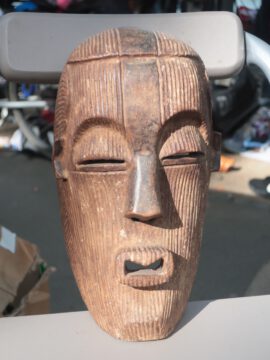 The grooves of a European hairstyle, that continue the vertical hatching of the face, appear to be combed back horizontally at the temples, and underneath show right-angles and acute-angles to the facial hatching
The grooves of a European hairstyle, that continue the vertical hatching of the face, appear to be combed back horizontally at the temples, and underneath show right-angles and acute-angles to the facial hatching
The slender face (the drawn-in cheeks),
Size : 25.8 x 14.5 x 14 (deep)
Small high-set ears
Half-closed eyes with bulging heavy eyelids, set off downwards by drawn lines,
The wide, short nose with the bridge of the nose at eye level, very deep, rounded nostrils,
Not to forget the protruding chin! 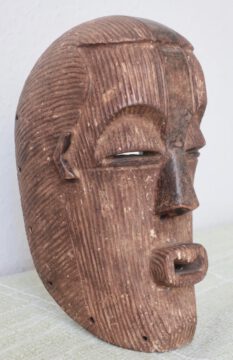
Seen from the side, the subtle design attracts still more our attention.
Interior view: regular wall thickness, good portability, visibility, distinctive perforations on the inside, pleasant smoothness with rounded edge.
And it’s a pure ‚Kifwebe‘!
Besides a vertical dark skull-nose stripe narrow vertical grooves (three to one centimeter) run down and radically cover even the protruding Kifwebe snout.
Résumé: Small ‘head’ . High concentration and perfection. Dense wood. Peculiarity confirmed in the “Kifwebe” context. Professionalism and perfectionism of the carver. Probably long-term use (delamination of the top layer reveals white pigments)
Brief discussion about naming the mask
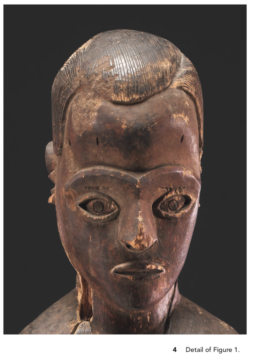 At the stand we talk about the hairstyle with the ‚receding hairline‘ – I remember one hundred and forty years with the whites in the Tetela region. Only gradually do I ‚discover‘ the ‚white‘ in the mask itself. What plays a role here is that in the Central Pende context I encountered the magical figure of the colonial agent Balot, whose death in 1931 triggered an uprising and his traumatic repression (LINK to the blog, there “fourth generation”).
At the stand we talk about the hairstyle with the ‚receding hairline‘ – I remember one hundred and forty years with the whites in the Tetela region. Only gradually do I ‚discover‘ the ‚white‘ in the mask itself. What plays a role here is that in the Central Pende context I encountered the magical figure of the colonial agent Balot, whose death in 1931 triggered an uprising and his traumatic repression (LINK to the blog, there “fourth generation”).
Special details of the gaunt face also seem to point in this direction: receding ratlines, realistic eyes, small ears, a – perhaps – commanding mouth (which in turn is typical of a Kifwebe type in the northwest (Neyt) and an energetic chin.
I decide to share my guess with Zoé S. Strother, one co-author of the study on the magical Balot figure: “Art with Fight in It – Discovering that a Statue of a Colonial Officer Is a Power Object from the Pende Revolt” by H.F. Weiss, R.B. Woodward, and Z.S.Strother in: African Arts, vol.49 no.1 spring 2016, photo on p.59. She is kind enough to answer my inquiery :
She knows similar hairstyles on a number of masks from the Kasai (East Pende, Biombo, etc.). She points out that working for Europeans generally (but when?) led to the imposion of the short hairstyle on men,. Also, the men of Kasai men often have this type of curved hairline. She expresses suspicion that this is a “modern” depiction, but she sees no reason to believe it is European, despite the figure’s long, narrow face. She suggests looking for dated photos of men in Kasai. (Email October 30th)
I shall follow up her suggestions. I recall that I had totally overlooked the fact of modernization of appearance among the urbanized ‚Évolués‘ of the ‚Belgian Congo‘ and to have written on „Two Modern Dancing Sticks of the Kuyu“ on the French-controlled banks of the Congo (LINK, deutsch). The prospect of a correspondingly dramatic colonial story simply blocked my view of known facts.
Comparative Overview of the four “Tempa”
Isn’t it too daring to associate the mask FOUR with ONE?
Their design suggests the same workshop. That’s what I feel: On the one hand, the subtlety, depth and breadth of the creation. On the other hand, the same care and clarity with the smooth bridges and surfaces of horns and forehead on ONE, and central browband and nose on FIVE.
The design distinguishes ONE from TWO and THREE, but the construction and smoothness of the nose correspond to those on FOUR. The pair looks more relaxed. They see us, their slightly open little mouths might be telling us something. On ONE I notice the strict withdrawal and the lowered gaze under heavy eyelids.
It is possible that different charisma results from the distribution of roles and not from different workshops.
1/6/2024 DOCUMENTATION Two Tempa masks from dealer A.
I immediately notice the close relationship of this object to the four masks ONE, TWO, THREE, FOUR of the same type from another source that W. purchased. This time there are even horns ADDED, wrapped in red scraps of fabric. But in the middle, a ’nest‘ of broken bird feathers and matted banana straw signals advanced decay – and vermin? The patina of white kaolin paste on the face has been so damaged by rain and abrasion during storage that no overall impression can be created. The creative hatchings can only be followed with the greatest concentration.
.
The visible deterioration takes away my desire to examine the object more closely, let alone ask the middleman from Cameroon what he expected from the transport and presentation on a mask stand. The ruin is just good for documentation and then for the bin. I am angry. How stupid does he think us flea market customers are? Or does he simply not understand the minimum conditions that apply to discarded cult objects in order to survive on any European market?
Next to it lies a second interesting mask from the same area, which shows similarities to FOUR in size and proportions, but is wild and powerful in appearance. His closed eyes are only indicated by two horizontal grooves. The grooves on the face are wide and shallow, with a shiny, darker layer of paint covering the surface. Two triangles are cut into the right and left at the level of the nostrils. The nose is plump, the mouth is slightly open in the shape of a leaf. A thin, long tongue made of a piece of leather protrudes from it. The braided framing of the face is intact; Short black and white pearl necklace pieces are tied to it on the right and left, but above all four (?) long straw-filled fabric sausages that hang down and move like snakes during the performance.
This mask would also require considerable restoration. This would be a solvable problem for a well-equipped museum, but where does it exist? Or would that be commercially viable?
On the other hand, the additions to the mask wood demonstrate, even in their decay, what is lost during stripping and cleaning – common practice for over a century.
So I get the rare opportunity to encounter African objects from the cult sphere in a no-man’s land.
Another confirmation: The cult, about which nothing or little is known, was still alive at least a few years ago. I photograph the objects with permission and now document what the fleeting encounter reveals.
Documentation of well-known Kifwebes
In: de Heusch Objects – Signs of Africa 1996: Dunja Hersak – Colors, Stripes….
p. 163 Fig.1 Kifwebe mask 32cm acq. 1971 Tervuren: 20768
Forehead… stripes, eye area, dark mouth (overstriped), traditional teardrop shape of the helmet, fewer grooves – inelegant impression, but: „… in private collections… monochrome category… may be filled with white“ (p. 162) There are even more Kifwebes with black stripes, also on shields, often slender in shape, but traditional.
Dunja Hersak shows elsewhere – in Face of the Spirits Herremans/Petridis – the range of eccentric creative Songye ‘exaggerations’! One exception is no. 74, pp. 154-55, 35 cm, but in the teardrop shape:
Relatively flat forehead,
The ears hold a central place as a wide open angle.
Short nose, but more trapezoidal
Prominent central band, but narrow and integrated into the stripes;
The receding hairline following the vertical grooves of the combed hairstyle, but harmonized parallel to the grooves on the cheeks.
No mounting holes? The edges are more angular, neater – gives a systematized impression
Slight shine on the surface, the grooves, if white, it has obviously been cleaned;
Grooves are really narrow anyway!
Provenience“Shaba”, no precise data! Hersak only (?) studied in the east of the Songye area.
1978, Alan P.Merriam published the essay “Kifwebe and other masked societies among the Basongye” in AFRICA-TERVUREN XXIV – 1978 – 3 u. 4 .
There are Illustrations titled both “Tempa Mask Eastern Kasai” and “Songye Mask Eastern Kasai”. But his topic is different and I can’t make out any textual references to the illustrations. “Kifwebe” refers to one of the three mask frets he examined, not to the external shape of the masks. (I have to adjourn!)
p.69 Songye mask Eastern Kasai 32cm Tervuren 20768 >
form of a arrow drop, with the forehead making up half the height.
Restless appearance, simply because the grooves are wide – less of them! At eye level 13 on each side instead of 20 on each cheek – and they are whitened.
Then the nose and especially the chin are not integrated.The short trapezoidal nose has horizontally decorated wings.
The bare surface reflects the lighting.
The area around the eyes is smooth and white and shows eyelashes The black central stripe widens on the forehead. Grooves radiate from it sideways and continue unbroken to the sides of the chin. Diagonally cut grooves meet on the long chin. This mask also seems to be helmet-like deep.
FIGURES
Neyt „Songye“
Stylistic region V – Sankuru et Lubefu p.127 “Statue masculine”
Neyt Songye p.136. no.100 – 60 cm high
More modern than comparable pieces Realistic forehead – with contrasting ‚receding hairline‘ and simply flattened ears Eye area: comparable eye sockets and trapezoid nose (Similarly the female counterpart no.101 p.137
